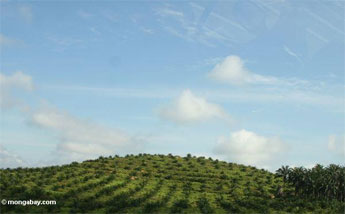Indonesia to have first biodiesel plant by 2008
Indonesia to have first biodiesel plant by 2008
mongabay.com
May 21, 2006
Indonesia plans to complete its first biodiesel plant by 2008.
The $25 million plant, built by PT Bakrie Sumatera Plantations Tbk (BSP) and PT Rekayasa Industri (Rekin), will have a capacity of 60,000 to 100,000 metric tons a year. The plant will use crude palm oil (CPO) and other feedstock.
According to the ITTO Tropical Timber Market Report. Indonesian demand for diesel is around 460,000 barrels
per day, of which 30% is imported. It says that analysts project that Indonesia will 14.7 million metric tons of palm oil in 2006, up 8 percent from 13.6 million metric tons in 2005. The country hopes that biodiesel can serve as an
alternative to imported diesel and that it can increase the proportion of palm oil used in the standard biofuel mix from 5 percent to 20 percent.
At $400 per metric ton, or about $54 per barrel, palm oil is competitive with conventional oil. In the future, palm oil prices are expected to fall further as more oil palm comes under cultivation.
 Oil palm plantation. Photo by R. Butler |
Oil palm is the world’s most productive oil seed. A single hectare of oil palm may yield 5,000 kilograms of crude oil, or nearly 6,000 liters of crude. As such large areas of natural forest are being converted for oil palm plantations across Indonesia. In the mid-1990s Indonesia set aside 9.13 million hectares for oil-palm cultivation, although by 2004 only about 5.3 million hectares of this area was actually planted.
RELATED
Why is oil palm replacing tropical rainforests? Recently much has been made about the conversion of Asia’s biodiverse rainforests for oil-palm cultivation. Environmental organizations have warned that by eating foods that use palm oil as an ingredient, Western consumers are directly fueling the destruction of orangutan habitat and sensitive ecosystems. So, why is it that oil-palm plantations now cover millions of hectares across Malaysia, Indonesia, and Thailand? Why has oil palm become the world’s number one fruit crop, trouncing its nearest competitor, the humble banana? The answer lies in the crop’s unparalleled productivity.
This article uses information from the ITTO Tropical Timber Market Report.